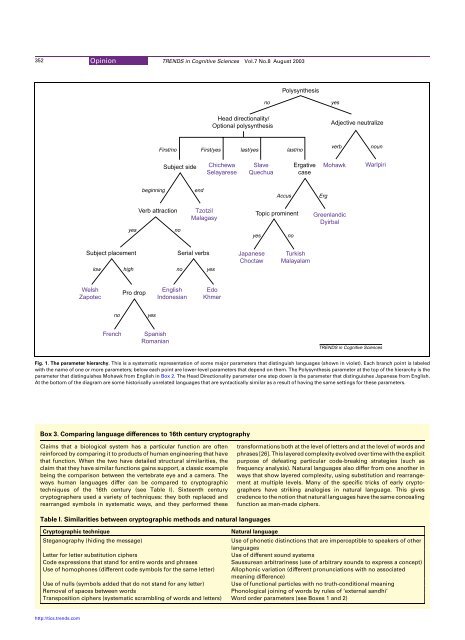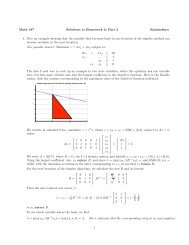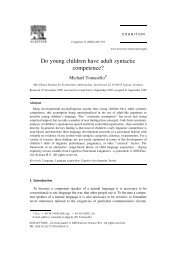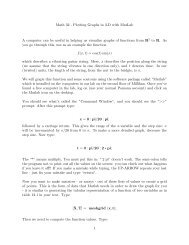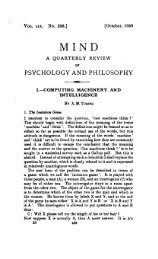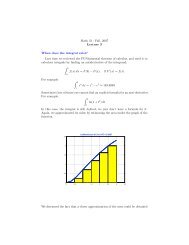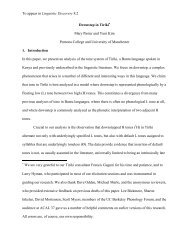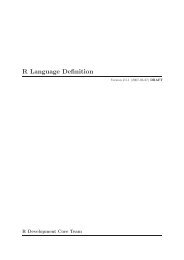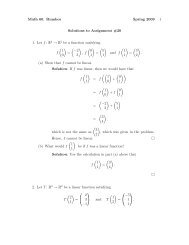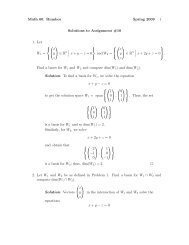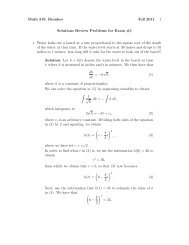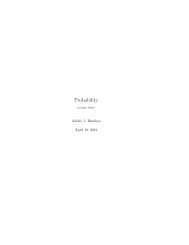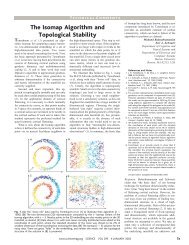352Opinion TRENDS in Cognitive Sciences Vol.7 No.8 August 2003PolysynthesisnoHead directionality/Optional polysynthesisyesAdjective neutralizeFirst/no First/yes last/yes last/noverbnounSubject sideChichewaSelayareseSlaveQuechuaErgativecaseMohawkWarlpiribeginningendAccusErgVerb attractionyesnoTzotzilMalagasyTopic prominentyesnoGreenl<strong>and</strong>icDyirbalSubject placement Serial verbs JapaneseChoctawlow highno yesTurkishMalayalamWelshZapotecPro dropEnglishIndonesianEdoKhmernoyesFrenchSpanishRomanianTRENDS in Cognitive SciencesFig. 1. The parameter hierarchy. This is a systematic representation of some major parameters that distinguish <strong>language</strong>s (shown in violet). Each branch point is labeledwith the name of one or more parameters; below each point are lower-level parameters that depend on them. The Polysynthesis parameter at the top of the hierarchy is theparameter that distinguishes Mohawk from English in Box 2. The Head Directionality parameter one step down is the parameter that distinguishes Japanese from English.At the bottom of the diagram are some historically unrelated <strong>language</strong>s that are syntactically similar as a result of having the same settings for these parameters.Box 3. Comparing <strong>language</strong> <strong>differences</strong> to 16th century cryptographyClaims that a biological system has a particular function are oftenreinforced by comparing it to products of human engineering that havethat function. When the two have detailed structural similarities, theclaim that they have similar functions gains support, a classic examplebeing the comparison between the vertebrate eye <strong>and</strong> a camera. Theways human <strong>language</strong>s differ can be compared to cryptographictechniques of the 16th century (see Table I). Sixteenth centurycryptographers used a variety of techniques: they both replaced <strong>and</strong>rearranged symbols in systematic ways, <strong>and</strong> they performed thesetransformations both at the level of letters <strong>and</strong> at the level of words <strong>and</strong>phrases [26]. This layered complexity evolved over time with the explicitpurpose of defeating particular code-breaking strategies (such asfrequency analysis). Natural <strong>language</strong>s also differ from one another inways that show layered complexity, using substitution <strong>and</strong> rearrangementat multiple levels. Many of the specific tricks of early cryptographershave striking analogies in natural <strong>language</strong>. This givescredence to the notion that natural <strong>language</strong>s have the same concealingfunction as man-made ciphers.Table I. Similarities between cryptographic methods <strong>and</strong> natural <strong>language</strong>sCryptographic techniqueNatural <strong>language</strong>Steganography (hiding the message)Use of phonetic distinctions that are imperceptible to speakers of other<strong>language</strong>sLetter for letter substitution ciphersUse of different sound systemsCode expressions that st<strong>and</strong> for entire words <strong>and</strong> phrasesSaussurean arbitrariness (use of arbitrary sounds to express a concept)Use of homophones (different code symbols for the same letter) Allophonic variation (different pronunciations with no associatedmeaning difference)Use of nulls (symbols added that do not st<strong>and</strong> for any letter) Use of functional particles with no truth-conditional meaningRemoval of spaces between wordsPhonological joining of words by rules of ‘external s<strong>and</strong>hi’Transposition ciphers (systematic scrambling of words <strong>and</strong> letters) Word order parameters (see Boxes 1 <strong>and</strong> 2)http://tics.trends.com
Opinion TRENDS in Cognitive Sciences Vol.7 No.8 August 2003 353Some researchers dismiss the idea that linguistic<strong>differences</strong> have a function out of h<strong>and</strong>. But we shouldalso be wary of evolutionary psychological reasoning if itleads us to downplay what is, because of unprovableassumptions about what must have been. The use of<strong>language</strong> in early human societies is not observable, <strong>and</strong>yet the reality of linguistic variation of a particular kind is,so we should focus on that. There are, after all, plenty ofunsolved questions about human cognition: intentionality,free will, a priori knowledge, abductive reasoning, <strong>and</strong> soon [32,33]. Many of these are clearly related to <strong>language</strong>[2]. We therefore need to remain open to new insights fromoutside the familiar range of assumptions.ConclusionThe extensive <strong>differences</strong> among human <strong>language</strong>s can beattributed to a small number of discrete <strong>differences</strong> in theunderlying rule system, known as parameters. In thisrespect, <strong>language</strong>s are similar to artificial codes,suggesting that <strong>language</strong> developed to prevent communicationas well as to permit communication. Furtherresearch is needed to complete the parametric account ofhow <strong>language</strong>s differ, <strong>and</strong> to develop theories of the originsof <strong>language</strong> that explain not only the existence of human<strong>language</strong>s, but also how they can differ so systematically.In particular, we need to explore alternatives to thesimplistic assumption that <strong>language</strong> exists only forcommunication.References1 Chomsky, N. (1981) Lectures on Government <strong>and</strong> Binding, Foris2 Baker, M. (2001) The Atoms of Language, Basic Books3 Kuno, S. (1973) The Structure of the Japanese Language, MIT Press4 Stowell, T. (1981) Origins of Phrase Structure, MIT5 Dryer, M. (1992) The Greenbergian word order correlations. Language68, 81–1386 Greenberg, J. (1963) Universals of Language, MIT Press7 Tomlin, R. (1986) Basic Word Order: Functional Principles,CroomHelm8 Koopman, H. (1984) The Syntax of Verbs, Foris9 K<strong>and</strong>ybowicz, J. <strong>and</strong> Baker, M. On directionality <strong>and</strong> the structure ofthe verb phrase. Syntax (in press)10 Mithun, M. <strong>and</strong> Chafe, W. (1979) Recapturing the Mohawk <strong>language</strong>.In Languages <strong>and</strong> Their Status (Shopen, T., ed.), pp. 3–34, WinthropPress11 Baker, M. (1996) The Polysynthesis Parameter, Oxford UniversityPress12 Mithun, M. (1984) The evolution of noun incorporation. Language 60,847–89313 Baker, M. (1988) Incorporation: a Theory of Grammatical FunctionChanging, University of Chicago Press14 Bickerton, D. (1990) Language <strong>and</strong> Species, University of ChicagoPress15 Bickerton, D. (1995) Language <strong>and</strong> Human Behavior, University ofWashington Press16 Carstairs-McCarthy, A. (1999) The Origins of Complex Language,Oxford University Press17 Lieberman, P. (1985) The Biology <strong>and</strong> Evolution of Language, HarvardUniversity Press18 Lieberman, P. (1999) Eve Spoke: Human Language <strong>and</strong> HumanEvolution, W.W. Norton19 Newmeyer, F. (1991) Functional explanation in linguistics <strong>and</strong> theorigins of <strong>language</strong>. Lang. Commun. 11, 3–11420 Jackendoff, R. (1999) Possible stages in the evolution of the <strong>language</strong>capacity. Trends Cogn. Sci. 3, 272–27921 Gallistel, C.R. (1995) Symbolic processes in the brain: the case of insectnavigation. In An Invitation to Cognitive Science (Vol. 3) (Smith, E. <strong>and</strong>Osherson, D., eds), pp. 1–51, MIT Press22 Aitchison, J. (1996) The Seeds of Speech: Language Origin <strong>and</strong>Evolution, Cambridge University Press23 Nowak, M. et al. (2001) Evolution of Universal Grammar. Science 291,114 – 11824 Nowak, M. <strong>and</strong> Komarova, N. (2001) Towards an evolutionary theoryof <strong>language</strong>. Trends Cogn. Sci. 5, 288–29525 Pinker, S. <strong>and</strong> Bloom, P. (1990) Natural <strong>language</strong> <strong>and</strong> naturalselection. Behav. Brain Sci. 13, 707–78426 Pinker, S. <strong>and</strong> Bloom, P. (1994) Humans did not evolve from bats.Behav. Brain Sci. 17, 183–18527 Newmeyer, F. (1998) Language Form <strong>and</strong> Language Function, MITPress28 Singh, S. (1999) The Code Book, Doubleday29 Paul, D. (1973) The Navajo Code Talkers, Dorrance & Company30 Bernstein, A. (1991) American Indians <strong>and</strong> World War II, University ofOklahoma Press31 Divale, W. (1973) Warfare in Primitive Societies, Clio Press32 McGinn, C. (1993) Problems in Philosophy: The Limits of Inquiry,Blackwell33 Fodor, J. (2000) The Mind Doesn’t Work That Way, MIT PressTICS Book ReviewsWe aim to review the best of the new books in Cognitive Science in TICS.Our book reviews are styled like short opinion pieces or mini-reviews of a subject area, with the aim of providing readers with morein-depth analysis. As well as critically appraising important new texts in the field, the authors of reviews will be encouraged to usethe book as a framework for wider discussion.Publishers: monographs <strong>and</strong> edited volumes (but not undergraduate textbooks) will be considered for review in Trends in CognitiveSciences. Please send us advance e-mails of forthcoming titles <strong>and</strong> copies of books you would like to be reviewed to the BookReview Editor at the address below.Trends in Cognitive SciencesElsevier London, 84 Theobald’s Road, London WC1X 8RR, UK.e-mail: tics@current-trends.comhttp://tics.trends.com


